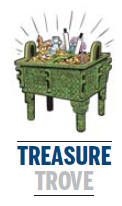Heritage
Chime bells and the rank and file
Updated: 2011-09-27 07:46
By Cheng Anqi (China Daily)
 |
Editor's Note:
Every week we look at a work of art or a cultural relic that puts the spotlight on China's heritage.Musical instruments made of bronze, especially bells, signified social stratification in ancient Chinese rites.
According to historical documents, kings of the Zhou Dynasty (c. 11th century256 BC) used four sets of bells; princes and dukes, three; senior officials, two; and officials in general, one.
Even today, most Buddhist and Taoist temples are equipped with bells, which are beaten during religious ceremonies.
Housed in the Palace Museum, the bronze bell shown here, known as bo, was the most popular type of bell in the Zhou Dynasty.
It weighs 16 kg and is 44.3 cm tall, with an almond-shaped, and not circular, cross section. This helps the sound to die quickly and not interfere with any music that follows.
When struck with wooden sticks, the bo produces a sound which is more musical than that produced by a circular bell. Both the bell's front and back is covered in animal patterns.
The front has what looks like a bird, while on the other side is a kui (a one-legged monster).
The ingenuity and craftsmanship of the maker are also evident in the four vividly portrayed tigers going down the body of the bo. As a result, the bell is known as Four Tigers Bo.
Cast flat, in two rather than three dimensions, they form the two side flanges.
Like ritual vessels, musical instruments also underwent great changes and variations in different periods and regions.
Before the Zhou Dynasty, people used the cymbal-like nao and zheng, probably the earliest known percussion instruments in China.
Such instruments have been uncovered at Anyang, Henan province. They have a flatter shape than the bo and are also much wider.
A nao chime is generally small with three to five graduated sizes in a set. Larger nao, often unearthed singly, were adorned with animals, especially elephant, motifs.
Nao continued to be popular until the establishment of the Western Zhou Dynasty (c. 11th century-771 BC).
At first, bian zhong, the chime-bells, came with a cylindrical handle on the top which could be suspended from a rack for striking, and a set of bian zhong had anywhere between three and 10 chime bells.

E-paper

Pearl paradise
Dreams of a 'crazy' man turned out to be a real pearler for city
Literary beacon
Venice of china
Up to the mark
Specials

Power of profit
Western companies can learn from management practices of firms in emerging economies

Test of character
Keyboard-dependent Chinese are returning to school because they have forgotten how to write

Foreign-friendly skies
About a year ago, 48-year-old Roy Weinberg gave up his job with US Airways, moved to Shanghai and became a captain for China's Spring Airlines.
